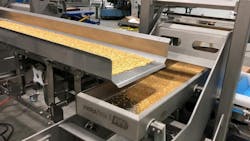Seven ways to get more from your food manufacturing conveyors
While conveyor applications in food manufacturing have traditionally focused on moving products between stations, their role can extend beyond simple transport. Innovative food manufacturing conveyors can help manufacturers streamline operations, reduce labor costs, and increase output. Consider the following seven additional conveyor functions when determining how to optimize operations.
1. Add applications to existing conveying equipment
Food manufacturers rely on conveyors to integrate production processes throughout their lines. Conveyance solutions from belt conveyors to vibratory and horizontal motion conveyors transport products from one end of the production floor to the other.
When such applications are added, conveyors can provide multi-functional capability, enhancing efficiency and reducing the need for additional machinery. Consolidating multiple processes into a single piece of equipment reduces the necessary floor space, optimizing the available area. Typical applications include:
• sizing, grading, and screening
• aligning and positioning
• merging and sorting
• product finishing
2. Introduce bulk handling
Bulk handling solutions introduce and manage large volumes of ingredients or loose products within the food processing line. Equipment systems consisting of dumpers, augers, storeveyors, and more hold and process products to keep production running efficiently.
Beyond moving a large quantity of product, bulk-handling conveyors can optimize how those materials are introduced to processes. Controlled release from storage systems can smooth out product flow, preventing surges that might overwhelm downstream equipment. They can also feed products into multiple processing streams to enhance capacity and throughput.
3. Elevate conveyors
Elevating conveyors maximizes floor space, allowing processors to increase production on a platform or mezzanine and seamlessly integrate equipment and processes at different heights.
By conveying vertically with belt incline conveyors, positive lift conveyors, screw augers, and bucket elevators, capacity and efficiency can be increased in a tight footprint.
Elevation can be taken even further by integrating inspection, X-ray, and other applications.
4. Enhance mix integrity
Mixing and blending solutions automatically maintain mix integrity for a wide range of foods such as mixed nuts, snacks, trail mixes, and vegetables. Implementing mix-blend systems that combine bulk handling hoppers and dumpers with vibratory feeders and collection conveyors provides precise recipes that improve yield, profitability, and product quality. These systems are configured to meet plant layouts and product mix needs.
Automatic, recipe-driven control systems can be adjusted as needed to enhance performance, volume, and flow rate to keep recipes consistent throughout production runs.
5. Merge and sort product flow
Merging and sorting conveyors optimize production and efficiency by seamlessly combining or separating multiple product flow lines between downstream and upstream processes. Reversing horizontal motion conveyors or a selection of belt conveyors keeps production running while maximizing throughput to multiple processes.
In addition to moving products, these conveyors accurately maintain alignment, orientation, and positioning for the most efficient handling and processing.
6. Accumulating performance
Accumulating conveyors play a major role in modern food processing lines. By temporarily storing and gathering products, they prevent disruptions, ensure a consistent product flow, and bolster production smoothness.
Storeveyors, distribution systems, and reversing horizontal motion conveyors buffer against surges or starvation to keep the line operational and avoid downtime.
Look for configurable solutions with sanitary stainless-steel designs, sensors, automatic controls, and first-in-first-out discharge options.
7. Consider positioning conveyors
Positioning conveyors such as retractors and spreaders ensure that products are accurately oriented and placed for subsequent processing steps. These conveyors orient, spread, index, or deposit products into rows and stacks, significantly increasing efficiency by manipulating products in-process and seamlessly connecting processing steps.
Integrating positioning belt conveyors maximizes production space and budget. Their versatility makes them applicable to a wide range of food manufacturing lines.
PFI



